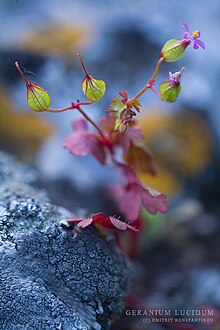Shiny cranesbill
| Shiny cranesbill | ||||||||||||
|---|---|---|---|---|---|---|---|---|---|---|---|---|

Shiny cranesbill ( Geranium lucidum ) |
||||||||||||
| Systematics | ||||||||||||
|
||||||||||||
| Scientific name | ||||||||||||
| Geranium lucidum | ||||||||||||
| L. |
The Shining cranesbill ( Geranium lucidum ) is a plant of the genus geranium ( Geranium ) within the family of geraniaceae (Geraniaceae). The main distribution area is the western Mediterranean area .
description
The shiny cranesbill grows as an annual to wintering green, perennial herbaceous plant and reaches heights of 10 to 40 centimeters. The ascending or upright, branched stem is usually red, fragile, almost bare, glandless and shiny. The leaves are divided into a petiole and a leaf blade. The glossy leaf blade is round in outline, five to seven parts up to the middle, with bluntly notched leaf lobes.
The flowering period extends from May to July. The partial inflorescences stand individually in the axils of the upper leaves. The short-stemmed, two-flowered inflorescences only slightly rise above the bracts. The sepals are erect, cross-wrinkled, clearly keeled and inclined at flowering time. The five light red petals are 8 to 10 mm long, obovate, rounded and long nailed.
The almost bare fissure flaps of the fissure fruit appear wrinkled below with a network of nerves.
The number of chromosomes is 2n = 20.
Occurrence
The original home of the shiny cranesbill is the western Mediterranean area , but it is now also found in Central Europe, including the German Eifel and Palatinate . Occasionally it can be found in Franconian Switzerland, on the lower reaches of the Lahn and Main , on the northern edge of the low mountain range , in Lower Austria , in western Switzerland and at the southern foot of the Alps .
The shiny cranesbill thrives best on nitrogen-rich, lime- deficient , stony loam soils ; but it also grows in cracks in walls and on ledges. He prefers partial shade. It grows in areas with mild winter and spring and populates there forest edges, forest clearings and walls. In Central Europe it is a character species of the Chaerophyllo-Geranietum lucidi (Alliarion association).
literature
- Schmeil-Fitschen: The flora of Germany and the neighboring countries . 95th edition, 2011, ISBN 978-3-494-01498-2
- Henning Haeupler , Thomas Muer: picture atlas of the fern and flowering plants of Germany (= the fern and flowering plants of Germany. Volume 2). 2nd, corrected and enlarged edition. Published by the Federal Agency for Nature Conservation. Ulmer, Stuttgart 2007, ISBN 978-3-8001-4990-2 .
- Dietmar Aichele, Heinz-Werner Schwegler: The flowering plants of Central Europe . Franckh-Kosmos-Verlag, 2nd edition, Volume 3
- Shiny cranesbill. In: FloraWeb.de. (Sections Description and Ecology)
Individual evidence
- ↑ a b c Shiny cranesbill. In: FloraWeb.de.
- ↑ a b Erich Oberdorfer : Plant-sociological excursion flora for Germany and neighboring areas . 8th edition. Verlag Eugen Ulmer, Stuttgart 2001, ISBN 3-8001-3131-5 . Page 628.
Web links
- Shiny cranesbill. In: FloraWeb.de.
- Profile and distribution map for Bavaria . In: Botanical Information Hub of Bavaria .
- Geranium lucidum L. In: Info Flora , the national data and information center for Swiss flora . Retrieved November 29, 2015.
- Distribution in the northern hemisphere according to Eric Hultén
- Thomas Meyer: Data sheet with identification key and photos at Flora-de: Flora von Deutschland (old name of the website: Flowers in Swabia )
- Collection of fabrics and photos at the NatureGate portal .


